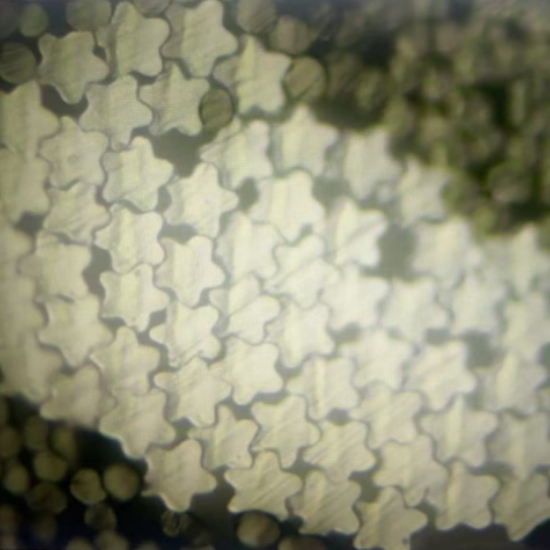Foam formation is a common issue in industrial processes such as pulp and paper manufacturing and concrete production. Excess foam not only disrupts production efficiency but can also compromise product quality and increase operational costs. To address this challenge, defoamers are widely applied, providing an effective way to control unwanted foam and maintain stable performance across different industries.
When it comes to choosing a reliable solution, Rickman defoamer stands out. Beyond delivering high-performance products tailored for pulp, paper, and concrete applications, Rickman provides professional technical support, fast response service, and customized solutions to meet diverse customer needs. The company’s commitment to innovation and customer care ensures that every client benefits from not just a product, but a complete service partnership.
Click on the related products links:RK-F0020(High Degassing Peformance Antifoaming Agent)/RK-50P(Highly Efficient Polyether Ester Antifoam)
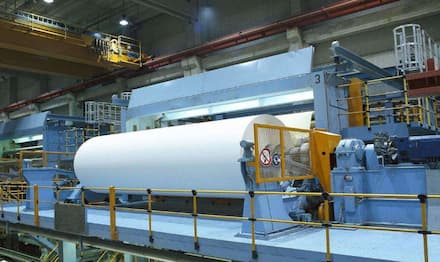
In the concrete industry, defoamers help control entrapped air during mixing. Excessive air bubbles can weaken the strength and durability of concrete structures, leading to cracks and reduced stability. The right defoamer ensures optimal air content, resulting in improved compressive strength, smoother finishes, and longer service life of concrete products. This makes defoamers a critical additive for construction companies aiming for reliability and safety in large-scale projects.
How to capture players by open water park in the night?
More and more water parks open in the night, especially in summer season, like Sea world Aquatica Orlando, Universal Volcano Bay, Aquaventure in Atlantis Dubai, Siam Water park, Chimelong Water park, Maya Playa in Xian OCT Group, Water World Ocean Park in Hongkong etc. which can attract more players for more consumption in the park. How they make it more attractive? Let's see what they do.

In Aquatica Orlando, they held different theme in different day of Aqua Glow, and decorated the park with LED lights to make it more attractive. Volcano bay take advantage of the "volcano"Krakatau, which decorated to "erupt" in the evening, and DreamWorks characters available to meet guests will include Shrek and Fiona and Puss in Boots and Kitty Soft Paws from Shrek, King Julien and Alex from Madagascar, and Poppy, Branch and Guy Diamond from Trolls.

In Aquaventure After Dark, UAE’s biggest moonlit waterpark party, Thrill seekers will love testing their nerve at The Leap of Faith, while there are 20 other fantastic waterslides to tackle one-by-one, including Shark Attack and Poseidon’s Revenge. A range of laser and fire shows will entertain and amaze in equal measures, with top musicians DJ Shef Codes and DJ Keza providing the soundtrack to an unmissable night. While there is an exclusive girls-only Chillax Zone for the ladies to let their hair down and enjoy the party.

In Chimelong Water park in Guangzhou, Except fireworks and light show, water slides and DJ party in the wave pool, they invited top fly boarder team as a part of the amazing show, to bring an unforgettable night for players.

In Siam Night to blow your mind and ignite your senses at the Siam Park, Fire Effects became a distinguishing feature alongside with slide tower and around the wave pool, DJ Music pumping, dancing Lights, Lasers Beams in Disco Fog over the Waves, shadows playing, water slides twisting, Luminous tubes on lazy River meandering - all coming together in a Symphony of Sights and Sounds. From July 1st to August 31st, whole water park becomes more enchanting under the cover of night.


"Get! Splash! Tonight!" event held on select weekends in Water World Ocean Park in Hong Kong, which includes Groove in Silence, Poolside Cheers, DJ in Your Area, and Luminous Cruise. More creatively, they offer Neon Face Painting Services, allowing you to join the fun with the most striking looks! which became an unique romantic experience with Photo Spot and take a ride on the "Lazy Cruise" with our special nighttime LED glowing inflatable tube.



These glowing inflatable tubes provided by Guangdong H-Fun, which can be switched to different colors and different light models, the water proof LED light can last 300 hours with 3 of AA batteries. We can print different customized designs on frost color material. These tubes could be essential to capture players with different creative ideas for night parties in water parks.
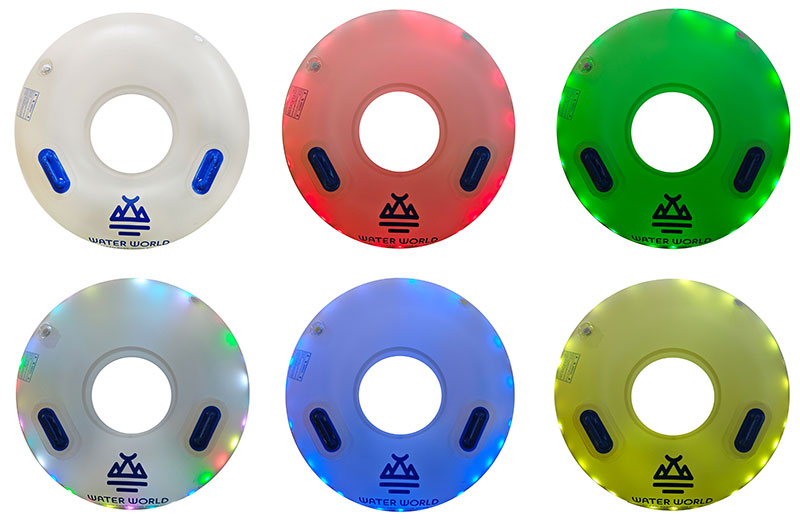
How to use inflatable test dummy
Inflatable humanoid water bags are made by tear resistant 0.9mm PVC tarpaulin, reinforced overlap heat bonding, which can simulate human weight in water park/ amusement park equipment test.
How to use it? here the instructions.
Take roller coaster testing as an example:
1. Unfold the product, keep 2 valves at “legs” closed and open the top valve.
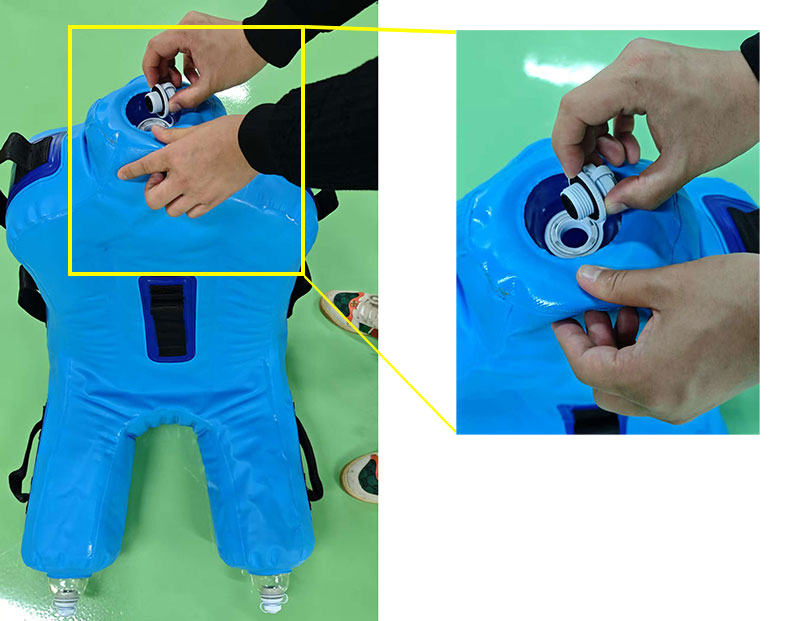
2. Fill water from top valve to 75kg or other weight required and close the valve.
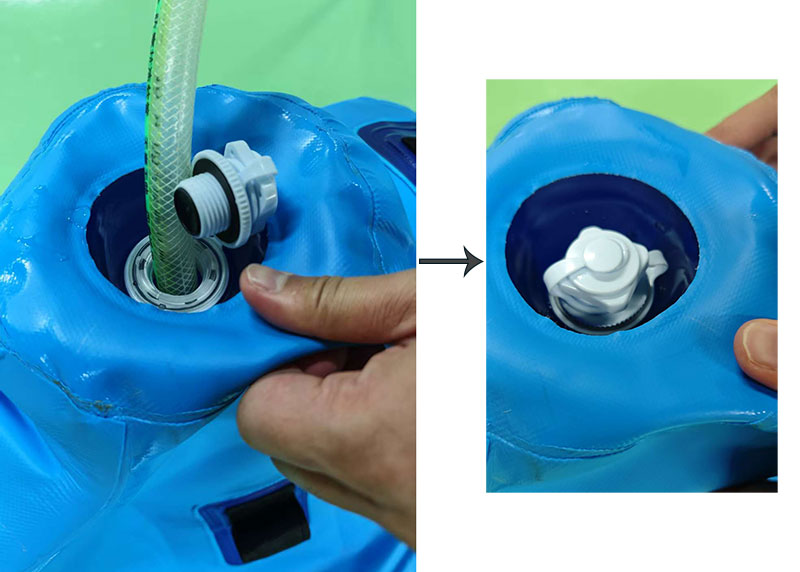
3. Move and carry the item with handles as shown to the equipment.
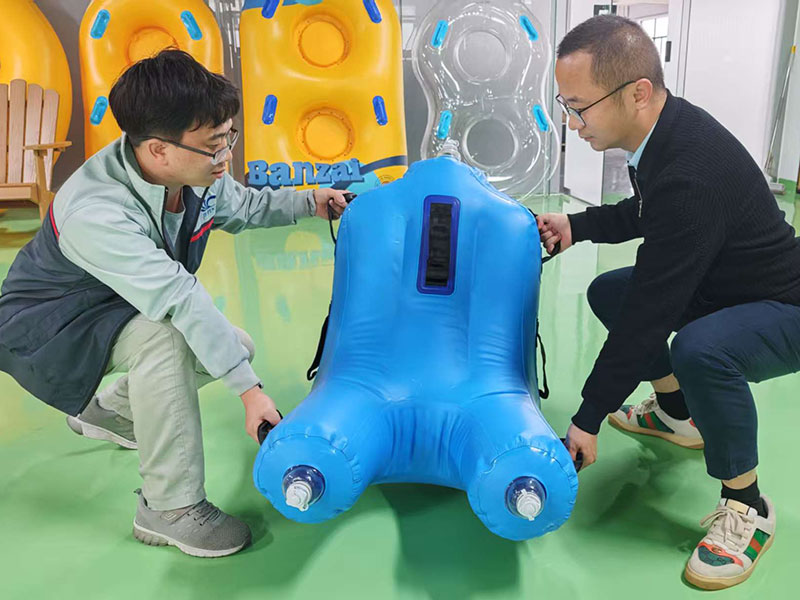
4. Fasten on equipment with belt or holder and test before running.
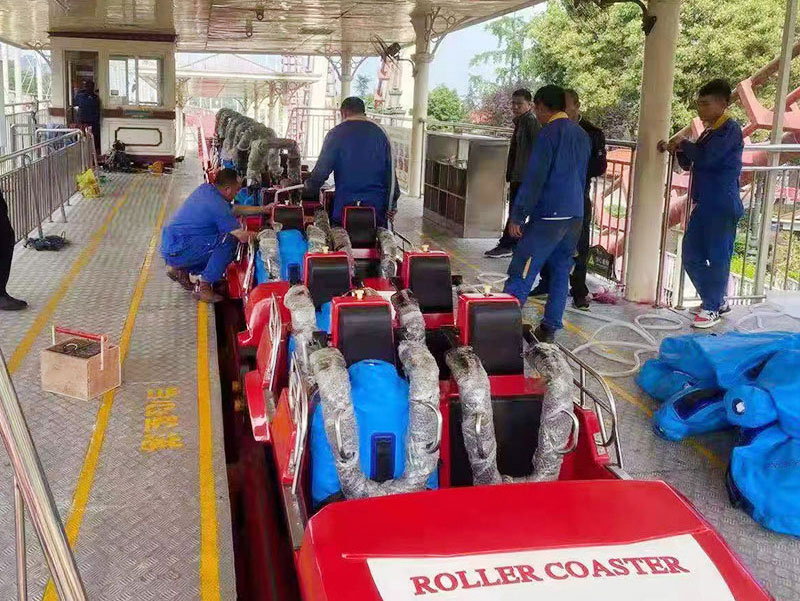
5. Open 2 valves at “legs” to drain water and close all valves for stock.

6. Rinse off and clean it with damp cloth or brush. Dry off before long term storage. Store it in a clean
and dry place. Avoid rain or direct sunshine.
7. The item can be repaired with PVC
patches and Locatite or Maxbond 5550 glue if small leakage.
8. We have 90kg, 75kg, 50kg types available.
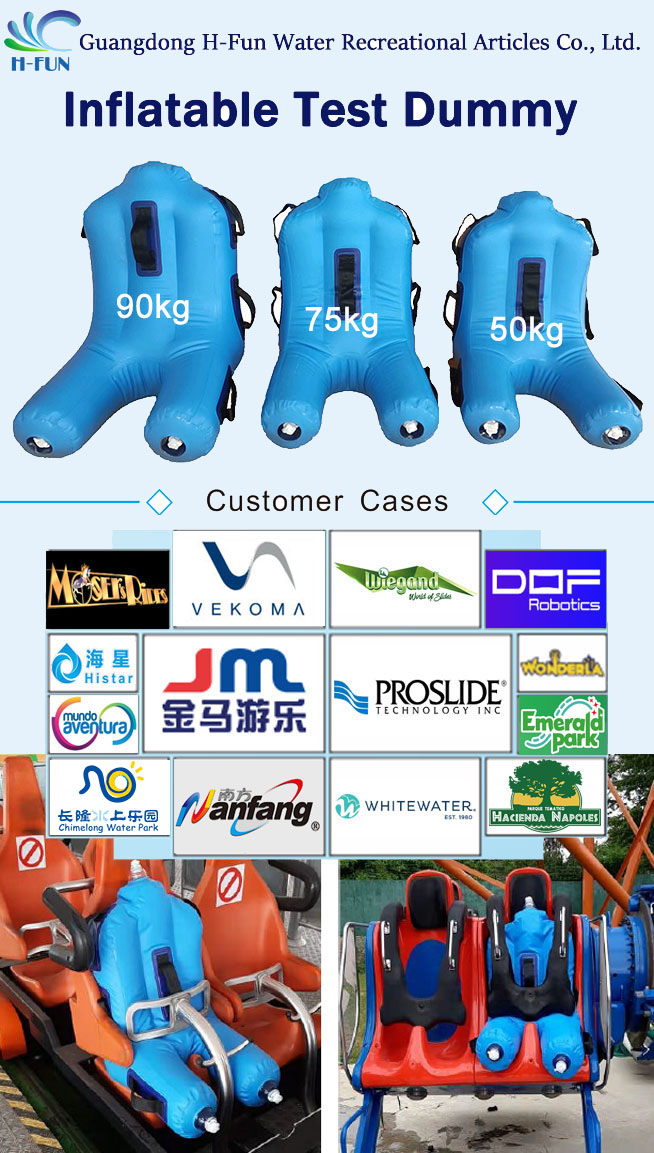
Why life jackets are necessary in water park?
Wearing life jackets in water parks is highly recommended for several important reasons:
1. Safety: Life jackets are designed to keep you afloat in water, even if you’re unable to swim. There could be different requirement between water park life jackets and other life jackets. Life jackets for yacht or boat are just back up for emergency, but life jackets for water park could be wear and soak in water every day, so they need to be more endurable. Neoprene life jacket are suitable for intensive using in water parks.
2. Unpredictable Situations: Accidents can happen anytime, even in seemingly safe environments like water parks. A life jacket provides an extra layer of safety, especially in crowded water areas where there may be unexpected currents, slippery surfaces, or sudden drop-offs.

3. Compliance with Rules: Many water parks have rules and regulations that mandate the use of life jackets in certain areas or activities. By wearing a life jacket, you comply with these safety guidelines and help preserve a safe environment for yourself and others.
4. Children and Non-Swimmers: Life jackets are particularly essential for children and non-swimmers who may not be able to stay afloat on their own. It provides parents and guardians with peace of mind knowing that their loved ones are protected in the water. Flexible design life jackets can match different body shape of players.

5. Prevention of Fatigue: Even strong swimmers can tire easily in water, especially when engaging in activities like water slides or wave pools. A life jacket can help prevent fatigue and provide additional buoyancy, allowing you to enjoy the water park safely for longer periods.

In conclusion, wearing a life jacket in a water park is a simple and effective way to ensure your safety and the safety of those around you, providing peace of mind and allowing everyone to have a fun and worry-free experience in water.
Guangdong H-Fun Water Recreational Articles Co., Ltd. provide professional water park life jackets , including Neoprene or Oxford fabric type. And we developed new design TPE foam life jackets for water park, Integrated molding without coating, can not peel off or damage at joint, comfortable and can use much longer time.

FD Antimony free yarn
New product
Customize for Full Dull
Specification: DTY 75D/72F FD, DTY 50D/72F FD
Widely usage according customer demands
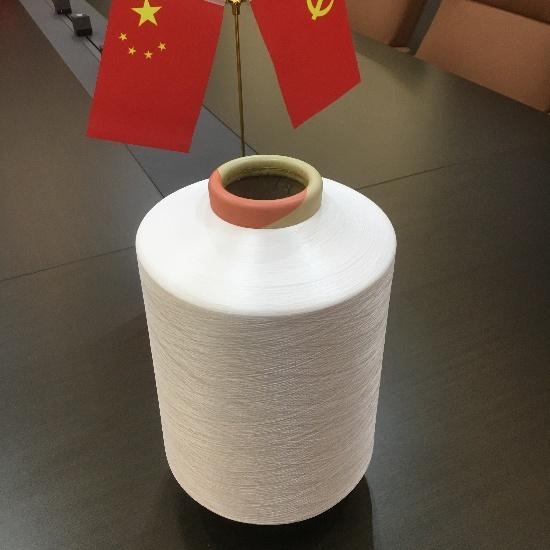
Full Ti(Titanium) Yarn Nanotechnology Functional Yarn
New nanotechnology functional yarn——Full Ti yarn,preferred materials for outdoors, shirts and T-shirts,achieving both technology and comfort.
Nanotechnology ensures more stable performance, and the excellent design of the integrated fabric structure features:
1.Thin yet impermeable, with excellent impermeability performance.
2.When used in combination with spandex, it provides a better draping effect and has a 5% increase in specific gravity compared to regular polyester.
3.Sunscreen performance has increased by an order of magnitude (UPF200+).
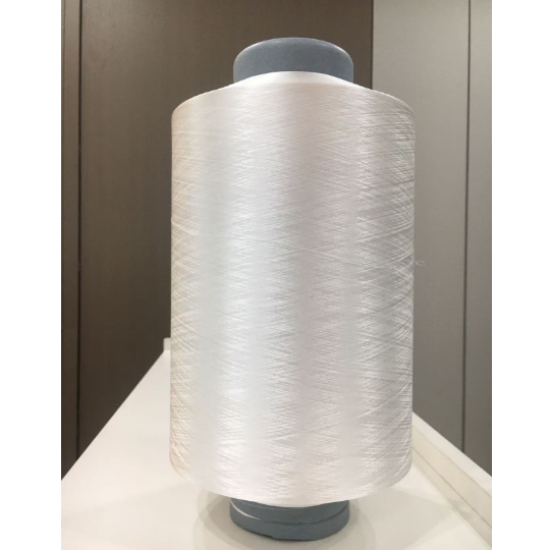
Broad-spectrum antibacterial properties/antistatic properties
1.Hide sweat stains, one-way moisture wicking.
2.Anti-pollution and self-cleaning function.
3.Duller than cotton.
4.Full coverage in daytime, with fabrics suitable for all seasons (plain cloth/plush/stretchy/cotton-like, etc.)
The specifications are as follows:
1. Single-ply Full Ti(Titanium) yarn: DTY 50D/72F、DTY 75D/72F2. Full Ti(Titanium) blended yarn:
FullTi Yarn DTY 50D/72F blended with SORONA 50D/32F
FullTi Yarn DTY 75D/72F blended with SORONA 75D/32F
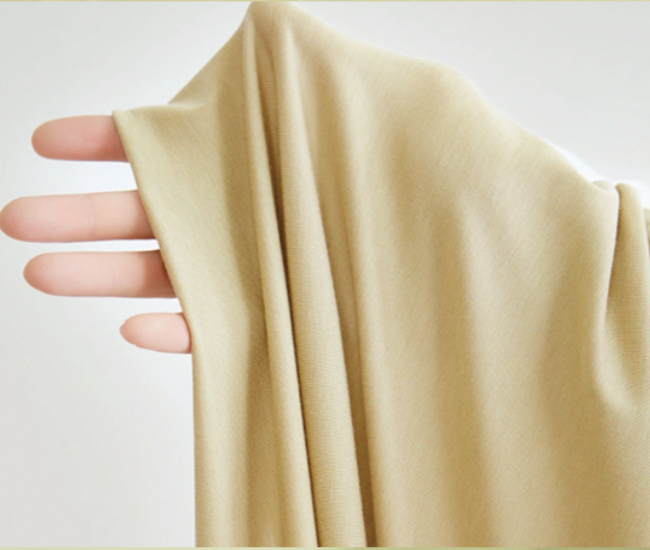
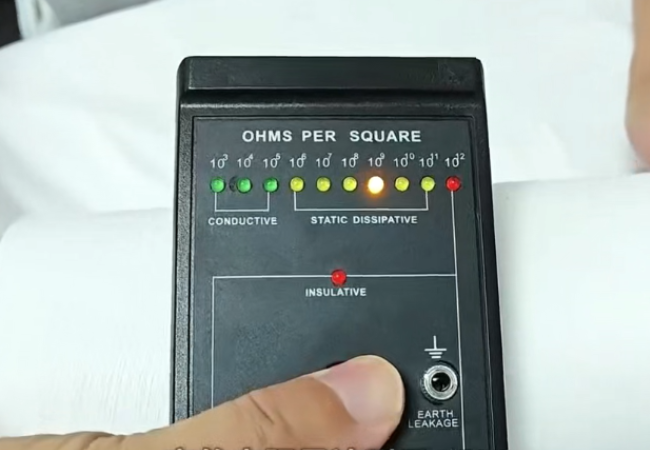
Honeycomb Polyester Filament Suitable for use in Sportswear
Honeycomb shape polyester filament draw inspiration from honeycomb structures to create a revolutionary material that combines ultra lightweight-breathable and multiple functions.
Honeycomb filament are made using high-molecular material addition technology, which gives the original yarn a honeycomb structure during the textile process.
However, unlike microporous structures, they form a bark-like capillary effect, with grooves that direct moisture away while also providing powerful functions such as deep dyeing, moisture absorption and quick drying, and ultra-lightweight breathability.
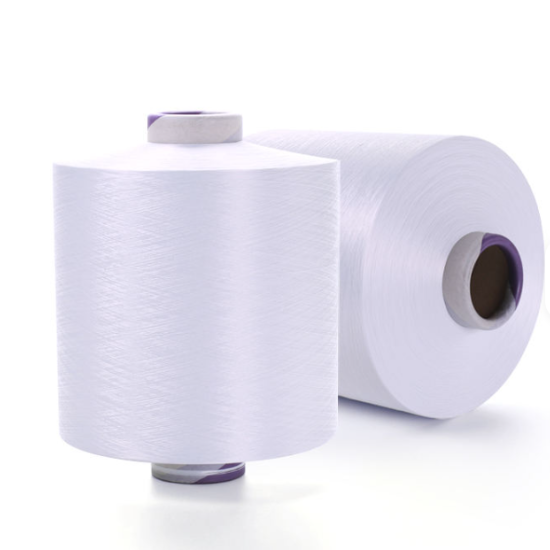
Features:
1. Moisture-wicking and quick-drying: Bark-like capillary effect, groove-oriented moisture-wicking function, evaporation rate reaches 0.5.
2. Deep dyeing-high color fastness: Honeycomb structure better adsorbs dye for deep dyeing and strong adhesion.
3. Ultra lightweight-breathable: Honeycomb shape, material weight reduction, strong breathability.
4. Full Matte Finish: Soft luster, non-glare, and non-blinding.
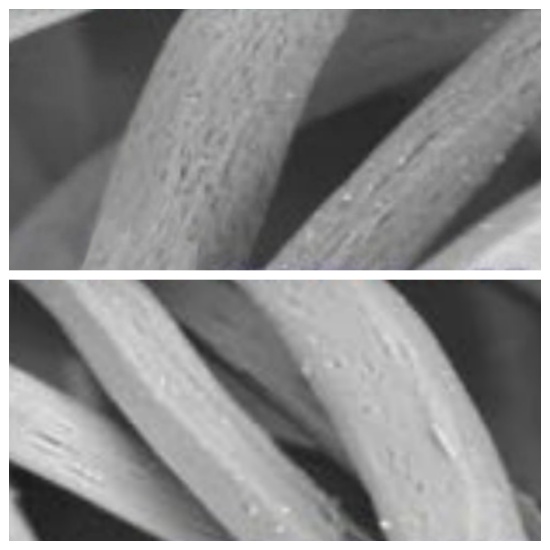
Mono Yarn equal to Yarn on Cops
What we often call MONO YARN is actually equivalent to Yarn on Cops in European parlance.
mono yarn iron cone = metal cops
and we also have paper cops, plastic cops
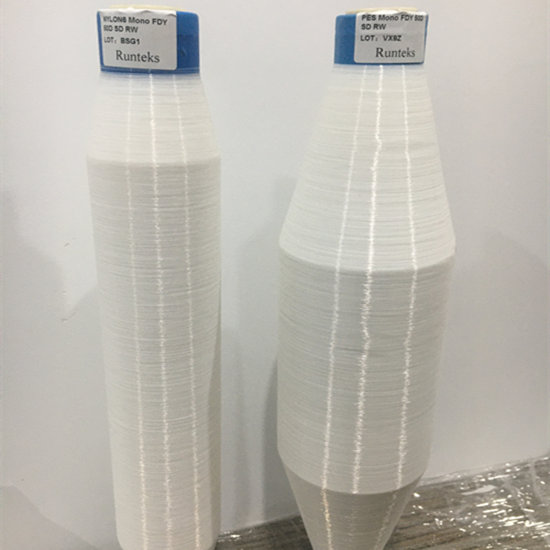
Runteks Upgrade Cooling Yarn Anti Bacteria+UV
1. Moisture wicking
The “+”cross-section structure of the fiber design can effectively and quickly absorb sweat on the skin surface, and through its unique moisture removal mechanism, the moisture can be quickly discharged from the body to keep the skin dry and comfortable.
2. Cool feeling
Integrating cooling technology into the masterbatch ensures that the fiber can release a cooling feeling the moment it comes into contact with the skin, bringing continuous cooling and comfort to the wearer. Whether it is on a hot summer day or during strenuous exercise, it can effectively reduce the temperature of the skin surface and provide an unprecedented cooling experience.
3. Antibacterial
By adding antibacterial factors within its fibers, it creates an environment that is not conducive to the survival of bacteria. Therefore, it can significantly reduce the growth of bacteria, thereby protecting the wearer's skin health and reducing skin problems caused by bacteria.
4. Anti-UV
The unique matting structure design and precision processing can effectively block ultraviolet rays. This structure greatly improves the fabric's ability to block ultraviolet rays by reducing direct exposure and reflection of light. Whether it is outdoor activities or daily travel, the cool matting structure can help protect the skin from ultraviolet damage.
Application scenarios
Summer lightweight clothing, sports clothing, home intimate clothing, outdoor sun protection equipment
Specification:
DTY 50D/48F FD
DTY 75D/72F FD
We can support customize some different specifications
Special Cross Section with Conductive Yarn
Runteks Group New Product
Special Cross Section with Conductive Yarn
1. Anti-Light
2. Cool feeling, quick drying
3. Special and multi shaped, cross section shape similar to a five-pointed star
Specification: 195dtex, 285dtex, 310dtex
Usage: suitable for army uniforms
